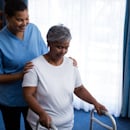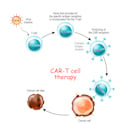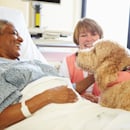Tracking a Mystery: The Eyes Have It
Eye-tracking technology is becoming an increasingly popular tool in the field of healthcare. From helping to identify neurological disorders to improving patient safety, the possible applications seem endless.
Eye-tracking is the process of measuring the point of gaze, or where a person is looking (Healthday, 2012). Advertisers have long used eye-tracking to maximize the capture of the consumer’s attention; designers use the technology to improve products, and game developers use eye-tracking technology to improve the latest gaming technology (Popovich, 2013). Clinicians are now also using this technology to assist in the diagnosis of certain mental and neurological disorders, such as autism, attention-deficit hyperactivity disorder, Parkinson’s disease and more.
Years of research have discovered that tiny, rapid eye movements (saccades) serve as a window into the brain and can provide information about our inner mental functioning. Distinct, abnormal eye-movement patterns can be identified in certain disorders. In autism, patients rarely make eye contact when looking at faces in an image or video in comparison with non-autistic kids (Popovich, 2013). Eye-tracking technology can also be used to diagnose Williams Syndrome, a rare congenital disorder associated with deletion of genetic material in chromosome seven (Williams Syndrome Association, 2012). Williams Syndrome is characterized by medical and cognitive problems, including cardiovascular disease, developmental delays and learning disabilities.
According to a study published in the Journal of Neurology in 2012, neurological disorders such as Parkinson's disease and attention-deficit/hyperactivity disorder can be detected by tracking eye movements while watching television (Popovich, 2013). A group of researchers at the University of Southern California’s i-Lab have devised a low-cost method of identifying brain disorders via eye-tracking. Subjects can view a video for 15 minutes while their eye movements are recorded; the results yield a wealth of information and algorithms which can distinguish deviant eye-movements from normal patterns (Popovich, 2013). The researchers of this study were able to identify elderly Parkinson’s patients with nearly 90% accuracy as well as children with attention deficit hyperactivity disorder (ADHD) or fetal alcohol spectrum disorder with 77% accuracy (Healthday, 2012). The researchers hope that this computer-led approach will lead to low-cost, widely available tests that don’t require expert reading. Although their test yields automated results, it is not meant to replace a more thorough assessment by a specialist.
Eye Tracking Technology in Healthcare
Now, exciting new studies reveal that eye-tracking can have many other useful applications. For nurses, eye-tracking technology can help determine where medication errors occur and what makes one nurse commit a medication error when another nurse is able to avoid one.
It's estimated that medical identification errors account for anywhere between 44,000 to 98,000 deaths per year (Eye-com, 2013). Nurses are the final safeguard against most medication errors as they are usually the last staff members to review a patient’s chart and are typically the ones in charge of administering the medications (Marquard et al., 2011). Recently, a study was done using eye-tracking technology to determine where these medication errors occur and what it is that makes a nurse slip-up. The study indicated a distinct difference in behavior and visual scanning patterns between nurses who incorrectly identified a patient and those who correctly identified a patient (Marquard et al., 2011). It also showed that nurses who correctly identified a patient were able to go through the correct steps in a shorter amount of time than those who were not. Researchers discovered that nurses who displayed random eye-movement when reading a chart, had a higher percentage of misidentification. They indicated that nurses who tried to remember many pieces of patient information at the same time (i.e. patient’s name and ID number), were more likely to make mistakes than nurses who would concentrate on one point of information at a time, then compare to the patient’s wristband or medication label (Eye-com, 2013).
It is clear that eye-tracking technology has many unique and varying applications. Yet, we may have only scratched the surface in terms of the applicability of this technology. There are many other examples of unique and untapped utilizations of eye-tracking technology today, such as stroke detection, brain tumor recognition and optic nerve lesion detection. Keep your eyes open to learn more about the use of eye-tracking technology.
References:
- Eye-com Research (2013). Eye-tracking study may help avoid fatal patient identification errors. Eye-Tracking Research. Retrieved from http://eyecomresearch.com/human-behavior/eye-tracking-study-may-help-avoid-potentially-fatal-patient-identification-errors/
- Healthday (2012). Simple Eye-tracking Can Identify Neurological Disorders. Doctor's Lounge. Retrieved from http://www.doctorslounge.com/index.php/news/pb/31854
- Marquard, J.L., Henneman, P.L., He, Z., Jo, J., Fisher, D.L. & Henneman, E.A. (2011). Nurses' behaviors and visual scanning patterns may reduce patient identification errors. Journal of Exp Psychol Appl. 2011 Sep;17(3):247-56.
- Newman-Toker, D. (2013). Eye-Tracking Tool Might Quickly Spot Stroke, UNC Healthcare. Retrieved from http://healthlibrary.unchealthcare.org/RelatedItems/6,674105
- Popovich, N. (2013). Eye-Tracking Software May Reveal Autism and other Brain Disorders. Scientific American. Retrieved from http://www.scientificamerican.com/article.cfm?id=eye-tracking-software-may-reveal-autism-and-other-brain-disorders
- Williams Syndrome Association (2012). Heart To Heart: Extraordinary Gifts, Unique Challenges - an Introduction to Williams Syndrome. Retrieved from http://williams-syndrome.org/ws
© 2013. AMN Healthcare, Inc. All Rights Reserved.




